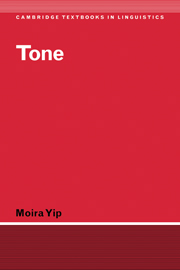Book contents
- Frontmatter
- Dedication
- Contents
- List of figures
- List of maps
- Preface
- Acknowledgements
- Notation systems, symbols and abbreviations
- Glossary of terms and abbreviations
- Alphabetical list of OT constraints
- Maps
- 1 Introduction
- 2 Contrastive tone
- 3 Tonal features
- 4 The autosegmental nature of tone, and its analysis in Optimality Theory
- 5 Tone in morphology and in syntax
- 6 African languages
- 7 Asian and Pacific languages
- 8 The Americas
- 9 Tone, stress, accent, and intonation
- 10 Perception and acquisition of tone
- Bibliography
- Author index
- Subject index
7 - Asian and Pacific languages
Published online by Cambridge University Press: 05 June 2012
- Frontmatter
- Dedication
- Contents
- List of figures
- List of maps
- Preface
- Acknowledgements
- Notation systems, symbols and abbreviations
- Glossary of terms and abbreviations
- Alphabetical list of OT constraints
- Maps
- 1 Introduction
- 2 Contrastive tone
- 3 Tonal features
- 4 The autosegmental nature of tone, and its analysis in Optimality Theory
- 5 Tone in morphology and in syntax
- 6 African languages
- 7 Asian and Pacific languages
- 8 The Americas
- 9 Tone, stress, accent, and intonation
- 10 Perception and acquisition of tone
- Bibliography
- Author index
- Subject index
Summary
Asia and the neighbouring Pacific regions are rich in tone languages, including as they do the Chinese language family, Tibeto-Burman, Tai-Kadai (which includes Thai), Vietnamese, and Papuan languages, as well as register-based languages like most of Mon-Khmer, and accentual languages like Japanese. There are of course also non-tonal languages, most prominently the Austronesian languages of Malaya and Indonesia, and the languages of the Indian sub-continent (although even here we find the occasional tonal language, such as Punjabi). The best-studied tone languages of this region are, not surprisingly, the urban languages of China, including Mandarin, Shanghai, Cantonese, and Taiwanese, and also Standard Thai, Vietnamese, and Japanese. No textbook on tone would be complete without a survey of the main characteristics of these systems, which between them illustrate both the commonalities and the diversity of the region. The remaining language families are less well studied from the point of view of their synchronic tonal phonology, although a great deal is known about their history. Nonetheless I will sketch out some of their most notable properties. Japanese is scarcely touched on, since its accentual nature puts it beyond the strict purview of this book, and it is thoroughly treated elsewhere. See especially Haraguchi 1977, Poser 1984, Beckman and Pierrehumbert 1986, Pierrehumbert and Beckman 1988, Vance 1987, and Kubozono 2000.
The following classification of the tonal languages in this region is rather coarse-grained, based on the following sources: Chen 2000, Matisoff 1973, Edmondson and Solnit 1988, Ladefoged and Maddieson 1996, and Grimes 2000.
- Type
- Chapter
- Information
- Tone , pp. 171 - 211Publisher: Cambridge University PressPrint publication year: 2002



